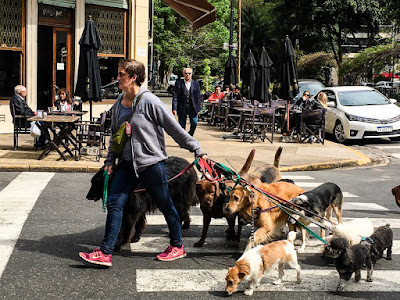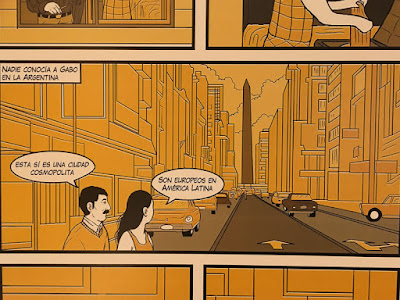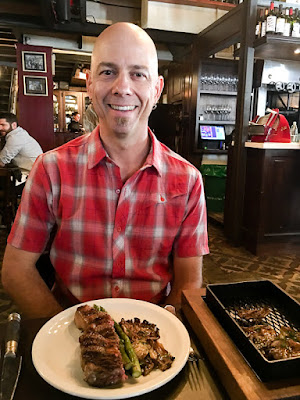
We took to the streets, curious to explore the history and culture of the city. One of the first things we noticed were lots of Catholic churches, a reminder of Argentina's Spanish colonial history.

Pirámide de Mayo commemorates May 25th, 1810 as the start of the Argentine Revolution against Spain, and it took another six years for the country to become fully independent.

Buenos Aires is the capital and largest city in Argentina. We went to Teatro Colón for a symphonic performance. The theatre opened in 1908.

The acoustics were wonderful, and we especially enjoyed hearing Bartok's Concerto for Piano and Orchestra No. 3 in E Major.

This is the outside of Teatro Colón after the performance.

Another old theater is now a bookstore. It was fun to browse in such a cool space.

These days Buenos Aires has plenty of contemporary architecture too. This is Florales Genérica, a steel and aluminum flower created by the Argentinian sculptor Eduardo Catalano in 2002.

We have seen a number of Sergio Calatrava bridges during our travels, so we were eager to visit Puente de la Mujer. The shape of the bridge is said to be an homage to the tango, with the male dancer leaning into his partner.

This view shows the contemporary buildings behind the bridge.

Her impact on Argentine politics is still felt today and she remains an icon. Her portrait is on the Ministry of Health building.
.
Recommended as the top tourist site in Buenos Aires, we visited La Recoleta Cemetery. It was the burial place for Argentina’s elites starting in the 1860s, and in 1881 this Doric-columned entrance was added.

Recommended as the top tourist site in Buenos Aires, we visited La Recoleta Cemetery. It was the burial place for Argentina’s elites starting in the 1860s, and in 1881 this Doric-columned entrance was added.

The cemetery is a hauntingly beautiful place, and we were happy to wander through the more than 4,500 grave sites.

There are plenty of interesting stories about the people buried here. Rufina Cambaceres is buried in this beautiful Art Deco tomb, and her's is a tragic tale of death at age 19. The photo also shows how the cemetary is laid out on a grid like a small city.

This statue is of Liliana Crociati de Szaszak, who was only 26 when she died in an avalanche. Sculpted in bronze by Viladrich, her beloved dog Sabú was added a few years later.

Dogs are really popular in Buenos Aires. We enjoyed seeing the paseo perros out with their charges.

The local dog walkers seem to generally have 7-8 pups in tow.

With all the parks in Buenos Aires, the pooches seem to live good lives here.

We were amazed at how many trees there are in Buenos Aires. Being in the southern hemisphere it was the beginning of spring during our visit, and these trees were still bare from winter.

Each day it seemed like we saw more evidence of spring.

The pink trumpet tree was one of our favorites.



And the jacarandas were starting to bloom, too.

And the yarn bombings adorning the tree trunks added color as well.

We checked out the National Library. Built in the Brutalist style in the 1970s, it looked like a massive, elevated concrete box to us.

Inside was an exhibit on the Gabriel García Márquez's book One Hundred Years of Solitude. Kristina was thrilled because she's been reading this book in Spanish.

This comic shows García Márquez and his wife visiting Buenos Aires for the first time. Their comments about it being a cosmopolitan city that looked European but with a Latin America heart resonated with us.

This year is the 50th anniversary of the book's publishing in Argentina (although it was published a year earlier in Columbia). García Márquez used this electric typewriter to write the novel.

And he was awarded the Nobel Prize for literature in 1982.

We visited the Latin American Art Museum (MALBA). The building was designed in 2001 by three young Argentine architects: Gaston Atelman, Martin Fourcade and Alfredo Tapia.

We happened to be there on the 25th anniversary of the Dîner en Blanc event that was happening in 70 cities around the world.

We stopped to watch the party take shape.

We visited the Xul Solar Museum, which is housed in the artist's former residence.

Xul Solar (1887-1963) was an Argentine painter, sculptor, writer, and inventor of imaginary languages. We enjoyed looking at his whimsical watercolor paintings.


We visited La Boca, a colorful neighborhood by the Buenos Aires port. Italians from Genoa (another port town) built La Boca in the 1880s, leveraging surplus materials they found around the port to build tenements.

Conventillos, shared tenements, were vulnerable to fire so large volunteer firefighter brigades were established. The mural on the lower wall shows firefighters rescuing a woman from a burning tenement.

A nearby mural had the firefighter theme, too.

In this mural La Boca, the mouth, is shown with the iconic transporter bridge as teeth. We were endlessly fascinated by the street art we saw in Buenos Aires.

Street art led us to investigate what happened during the Dirty War (1976-83). Thirty thousand (30,000) Argentines were kidnapped and killed by the military dictatorship. These people are known as los desaparecidos, the disappeared. Starting in 1977, mothers of the disappeared took to the streets to protest their children being kidnapped. They marched in silent pairs in La Plaza de Mayo because groups were prohibited from gathering in public. This mural shows the sun as an icon for Argentine protest next to one of the mothers with a kerchief on her head.

Another mural shows the faces of some of the disappeared with the slogan Never Forget, Never Pardon.

We learned that the mothers would embroider the name of their missing child on their kerchief, so it was obvious who they were looking for, enabling someone who knew about their child to give them a message.

Stencils are frequently used here to share political ideas. Don't forget the disappeared.

We took a street art tour with Graffiti Mundo to learn more about Buenos Aires street art. This enormous mural is a grill scene entitle El Puntero by Argentine Franco Fasoli. He studied scenography at Teatro Colón and he used techniques from his scenography work.

Pete noticed some shoe tossing, Buenos Aires style. Some of the young women here have a penchant for wooden platform shoes.

Fasoli's street artist name is JAZ. This is an older mural of his with our guide Sorcha. His last name Fasoli is above the lion.

JAZ teamed up with another Argentine street artist named Pastel to paint these murals below an overpass. The artworks feature a series of half-man half-beast characters painted by Jaz and flora painted by Pastel. Pastel is also an architect.

Sorcha took us to see these cool bicycle inventions in the Barracas neighborhood. Artists Corona, Mart and Maese Warrior painted them as part of a project organized by the Sullair company, which builds and rents cranes and lifting machines used by street artists. The bicycle murals adorn Sullair's exterior plant walls. Of course our favorite was the fantastical tandem.

We happened to walk by this lovely mermaid and thought she might be able to hop onto the propped bike below and ride away.

Nicolás Sanchez, an urban artist from Uruguay who goes by Alfalfa painted this enormous and detailed mermaid in Barranco. His mural consists of tiny black and white lines, but the colors read as chalky pastels. (Click on the image for a closer look.)

Sorcha showed us how mosaics are part of the visual landscape in the Barracas neighborhood, too. Artist Marino Santa María was the first to renovate the façade of his studio. His experiment became so popular that the city government offered financial support in renovating 35 more façades along the street. A couple years later, Paseo Lanín became an official cultural site protected by UNESCO. Here's a window detail that we liked.

The bandoneón, an accordion-style instrument that is popular in tango music, is frequently featured in Buenos Aires street art.

Later we found mosaics in other neighborhoods too.

Sorcha explained that in the years following the Argentine great depression 1998-2002 some artists were inspired to cheer people up so they created art that with cartoon figures.
Graffiti Mundo recently helped produce White Walls Say Nothing, a feature-length documentary about art and activism in the streets of Buenos Aires. This quote is from the film, "This powerful tradition of expression in public space, of art and activism, has made the streets of Buenos Aires into a riot of color and communication." And here's a link to a review with the trailer. These old beer cans have been transformed to say "paint the walls".

This is El Quetzal. The facade was painted by Mariela Ajras in 2016 and is titled Interferences. An interpretation of time. In an interview Mariela explained, “The woman is not necessarily anyone in this case but a surrogate of any woman, an image of a memory, a distant and blurry person who was a part of someone’s memory randomly (or not) and now is the remains of an event which is barely remembered.”

Over the doorway we noticed a sculpture of a quetzal.

And in the window we read, "We are the color of the earth". This is a Subcomandante Marcos quote. He was the leader of the Mexican Zapatista resistance movement until 2014.

Intrigued, we researched more about El Quetzal and learned that inside is a mural of the same name by artists Guache and El Marian. Guache explains the mural, “‘We are the Color of the Earth’ refers precisely to the holistic dimension of resistance, not just the kind of resistance that implies clashes or violence, but the broader act of going against a system. And it’s more than being against something because resistance is also the act of constructing a proposal for a new culture based in solidarity, equality and equity…” Here's a photo from El Quetzal's website that shows them painting it.
Ever is the name of the artist who painted this mural. “I wanted to create something mysterious and for me the triangle adds a sense of mystery to the artwork”.

We saw several of Ever's murals, all with eyes painted as waving bands of color. The lower figures in this mural reminded us of Diego Rivera murals we had seen in CDMX.

Argentine street artist Alfredo Segatori created ‘El viejo de Desarmadero trash’ earlier this year. The artwork features a portrait of an old man created out of recycled items such as a car parts, bicycle wheels, tires, rusty cans, a computer, a telephone and scrap metal and it forms the front of the Desarmadero Bar in Palermo Viejo.

Artist Martin Gordopelota created this mural. He says, “My main inspiration is amateur futbol in Argentina, specifically five-a-side matches that most of all Argentinians play during the week with friends. I love the idea of representing the cultural-social side of beer bellies and cigarettes in opposition to the big industry of Messi-Ronaldo-Machine players,” explains Martin. Notice the soccer ball earring.

We love this piece by Pum Pum. A graphic designer by trade, here's what we learned about her art. "The iconic two-dimensional protagonists that define her work are created with bold color and clean lines, and are characterized by a mixture of the artist’s own eclectic influences: from Hello Kitty to legendary hardcore punk bands like Black Flag."

US street artist Limpio created this mural in 2016 that features a stag in a Patagonian landscape.

We went to Barrio Chino, the Chinatown neighborhood of Buenos Aires to look at street art. We saw a wall painting of a blooming cherry tree playing a bandoneón, so we knew we were in the right place.
This giant goldfish is by Indigo Ars, a local artist who completed several murals here in 2016.

Indio Ars also painted this awesome bird mural just down the street from our Airbnb in Palermo Hollywood.
We happened to walk by this all female crew of artists working on a this wall.

This is Homeless Bound by Australian Fintan Magee. The artwork was painted on a boarded-up house in Palermo. It shows a man burdened by the weight of a house he is carrying on his back and relates to the global housing crisis. The man in the mural is Matt Fox-Tucker, who founded Buenos Aires Street Art and funded the mural.

We couldn't find out who painted this mural Salvaje Espiritu, Wild Spirit, but it reminded Pete of the Spanish story he's reading called La Ciudad de las Bestias by Isabelle Allende that includes a young woman in the Amazon who has a pet monkey and paints her face.

There are also lots of street artists here who use stencils.

And stencils are used to share political messages, like this endorsement of Cristina Kirschner for President from 2011. She was the first female elected President in Argentina and served two terms from 2007 to 2015.

This colorful wall is the exterior of a bar in our neighborhood that includes stencils, stickers and paint.

Also nearby is this gorgeous blue and yellow mural by local artist Cabaio Spirito for Moroccan restaurant Tetuán. We learned that the older man is Alfonso Benaim, the great uncle of the restaurant creators Nicolás Wolowelski and Juan Martin Migueres. The restaurant owners are cousins with North African heritage that stretches back to the city of Tetuán when it was the capital of Spanish Morocco.

This close up shows how Spirito painted Benaim in a charcoal-like style on top of intricately-painted arabic tiles.

We went to Tetuán for lunch, which included house-made pita bread with humus and a variety of Moroccan-spiced vegetables and meat.

We tried other ethnic restaurants in Buenos Aires, including Mishiguene, an excellent Jewish restaurant.

The broiled fish with cauliflower puree topped with pesto was a savory delight.

We also went to Peruvian restaurant La Mar twice because their ceviche was so good. This is Tiradito Nikei, which has Japanese influence. The dish was trout ceviche with passion fruit leche de tigre and a honey Nikei sauce that was amazing.

We also ordered the more traditional Peruvian Arroz Norteno, wok fried rice topped with eggs.

On our second visit to La Mar we couldn't decide so we ordered a ceviche sampler.

Their drinks were also stellar, lemonade with mint and ginger, and pomelo with thyme.

The weather was nice so we sat in the patio and celebrated our 31st anniversary as a couple.

Occasionally for breakfast we went for coffee and medialunas, thick and doughy croissants that seem to slide down effortlessly.

At La Cocina we found the best empanadas. Here are a selection of spicy meat, spinach with egg and chicken stew. All were piping hot and stuffed full of tasty fillings.

Being in Argentina, the land of amazing beef, we went twice to Don Julio Parilla for grilled meat. As we entered the restaurant we couldn't believe how great the wood fired grill smelled.

And we were impressed to see the cuts of beef that were being prepared for grilling.

We started with the sausage sampler: spicy lamb longaniza is in the center with beef salchicha on the right and pork chorizo on the left. It was served with different types of chimichurri sauce.

Don Julio's specializes in sirloin, so we ordered a thick cut sirloin to share, along with grilled oyster mushrooms and asparagus.

Pete looks happy with his meal.

We were discovered the artisanal ice cream scene in Buenos Aires. Kristina was pleased with her pink grapefruit sorbet.

Our favorite shop was Rapa Nui, and they even make their own chocolate bars. Yes Pete, you have to share some of that gianduia, bitter chocolate gelato with hazelnuts.

Can you believe how tall the mint chip ice cream cone is? The servers at Tufic competed to see who could make the tallest cucurucho, trumpet.

And our final treat in Buenos Aires was Turkish chocolate with walnuts, figs and honey. What a wonderful month!

Next we fly to Chile for cycling and urban adventure.










